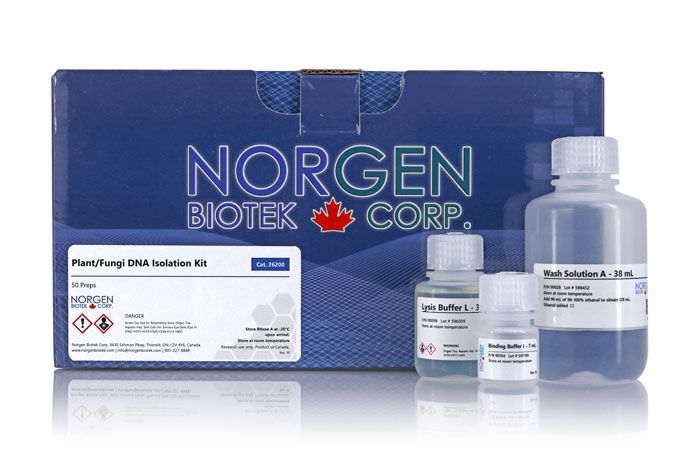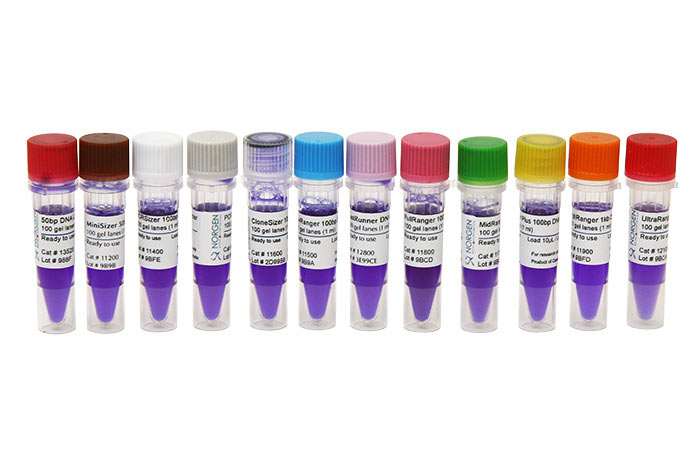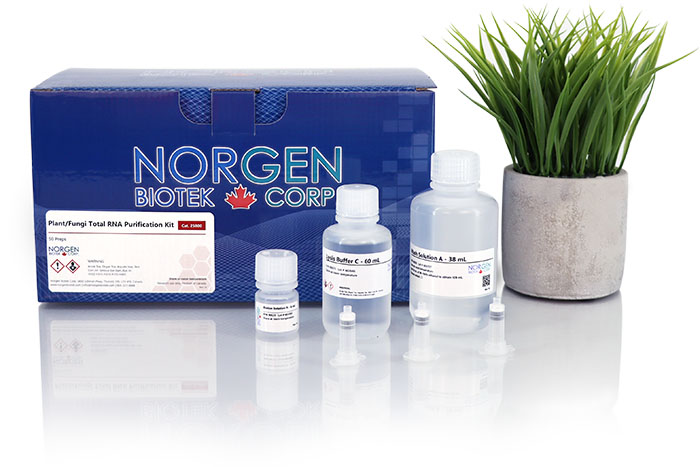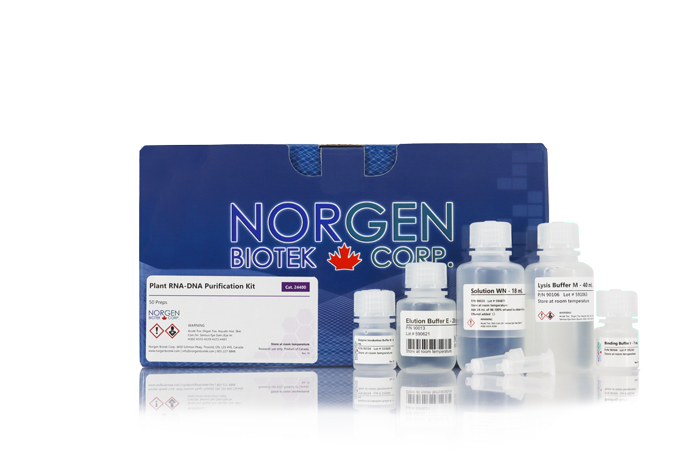Plant/Fungi DNA Isolation Kits

For research use only and NOT intended for in vitro diagnostics.
Plant/Fungi DNA Isolation Kits
Register today to receive an exclusive 15% off* on your first order.
Supporting Data
Figure 1. Isolate DNA from a Wide Range of Plants. DNA was isolated from 50 mg samples of tobacco leaves (Lanes 1 and 2), tomato leaves (lanes 3 and 4), peach leaves (Lanes 5 and 6) and grape leaves (lanes 7 and 8) using Norgene’s Plant/Fungi DNA Isolation Kit, and 5 µL aliquots of the 100 µL elutions were run on a 1x TAE 1% agarose gel. As it can be seen, high quality DNA was isolated in all cases. The M lanes contain Norgen’s HighRanger 1Kb DNA Ladder.
Figure 2. Purified DNA can be Amplified in a Real-time PCR Reaction (SYBR Green). DNA was isolated from 50 mg samples of plum and tobacco frozen leaves using Norgen’s Plant/Fungi DNA isolation Kit, and 2 µL of the eluted DNA was used in a real-time PCR reaction (total reaction volume 20 µL) with 18sr DNA primers (95°C for 3 minutes and 40 cycles at 95°C for 15 seconds and 60°C for 30 seconds). The real-time PCR was successful in amplifying both the plum and tobacco DNA, indicating that the DNA is of a high quality and can be used in sensitive downstream applications.
Figure 3. Resolution of DNA isolated from four different plant species. DNA was isolated from four different plant species using Norgen’s Plant DNA Isolation Kit (Magnetic Bead System) and Norgen's Plant/Fungi DNA Isolation Kit (column format, Cat. 26200). For evaluation, 10 µL from 75 µL of elution were run on 1X TAE 1.2% agarose gel. Excellent DNA integrity and yield were observed from the Plant DNA Isolation Kit (Magnetic Bead System) (Lanes 1 to 3), indicating the robust performance comparable to the column based method (Red C). Marker = Norgen’s HighRanger DNA Ladder./p>
Figure 4. High DNA Quality. DNA was isolated from a number of plant species using Norgen's Plant DNA Isolation Kit (Magnetic Bead System) and Norgen's Plant/Fungi DNA Isolation Kit (column format, Cat. 26200). The purified DNA was then compared for DNA quality (A260/280). All DNA elutions isolated using Norgen’s Plant DNA Isolation Kit (Magnetic Bead System) showed an excellent comparable DNA quality to Norgen’s Plant/Fungi DNA Isolation Kit (column based, Cat. 26200), indicating the consistent and robust performance of the Plant DNA Isolation Kit (Magnetic Bead System).
Figure 5. High DNA quality was confirmed by Real-time PCR. DNA was isolated from six different plant species using Norgen's Plan DNA Isolation Kit (Magnetic Bead System) and Norgen's Plant/Fungi DNA Isolation Kit (column format, Cat. 26200). To assess the quality of the purified DNA, 8 µL of the elution (total PCR reaction volume was 20 µL) was used in a real-time PCR reaction. As it can be seen, 18s rDNA amplification was successful in all cases without PCR inhibition, indicating the excellent quality of DNA purified using Norgen’s Plant DNA Isolation Kit (Magnetic Bead System).
Figure 6. DNA was Isolated From Plant Tissue Using Norgen’s Plant DNA Isolation 96-Well Kit (Magnetic Bead System). For evaluation, 10 µL from 75 µL of elution were run on 1X TAE 1.2% agarose gel. Excellent DNA integrity, consistency, and yield were observed from the Plant DNA Isolation 96-Well Kit (Magnetic Bead System). Marker = Norgen’s HighRanger DNA Ladder (Cat. 11900).
Figure 7. High DNA Quality Confirmed By Real-time PCR. DNA was isolated from plant tissue species using Norgen's Plant DNA Isolation 96-Well Kit (Magnetic Bead System). To assess the quality of the purified DNA, 2 µL of the elution (total PCR reaction volume was 20 µL) was used in a real-time PCR reaction. As it can be seen, 18s rDNA amplification was successful in all cases without PCR inhibition, indicating the excellent quality of DNA purified using Norgen’s Plant DNA Isolation 96-Well Kit (Magnetic Bead System).
|
Kit Specifications - Spin Column
|
|
| Column Binding Capacity |
50 μg
|
| Maximum Column Loading Volume |
650 μL
|
|
Maximum Amount of Starting Material:
Plant Tissues
Fungi (wet weight)
|
100 mg
100 mg |
| Average Yields* 50 mg Tomato Leaves 50 mg Grape Leaves 50 mg Peach Leaves 50 mg Plum Leaves 50 mg Pine Needles Botrytis cinerea (50 mg wet weight) Fusarium sp. (50 mg wet weight) Aspergillus niger (50 mg wet weight) |
18 µg 10 µg 10 µg 10 µg 5 µg 1.5 µg 2 µg 4 µg |
| Time to Complete 10 Purifications | 45 minutes |
* Average yields will vary depending upon a number of factors including species, growth conditions used and developmental stage.
* Average yields will vary depending upon a number of factors including species, growth conditions used and developmental stage.
Storage Conditions and Product Stability
All solutions should be kept tightly sealed and stored at room temperature, except for the RNAse which should be stored at -20°C. This kit is stable for 1 year after the date of shipment.
Select Plants and Fungi that can be used with the Plant/Fungi DNA Purification Kits
| Plants | Plants (Cont'd) | Fungi |
| Tomato | Turnip | Aspergillus niger |
| Grape | Chinese Cabbage | Mucor racemosus |
| Peach | Radish | Cladosporium cladosporioides |
| Plum | Komatsuna | Fusarium oxysporum |
| Pine Needles | Apricot | Penicillium sp. |
| Raspberry | Sweet Potato | Botrytis cinerea (Botryotinia fuckeliana) |
| Strawberry | Hydrangea | Pichia sp. |
| Legumes | Fig | Rhizopus oryzae |
| Prosopis cineraria (Ghaf) | Turf | Alternaria tenuissima |
| Sorghum grass | Cherry | Fusarium sp. |
| Tobacco | Saintpaulia | |
| Arabidopsis | Lotus | |
| Lichen | Carrot | |
| Corn seed | Hansen | |
| Sunflower seed | Pistachio | |
| Olive seed | ||
| Soybean seed |
| Component | Cat. 26200 (50 preps) | Cat. 26250 (250 preps) | Cat. 26900 (192 preps) | Cat. 58200 (50 preps) | Cat. 62400 (192 preps) |
|---|---|---|---|---|---|
| Lysis Buffer L | 30 mL | 1 x 30 mL 2 x 60 mL |
2 x 60 mL | 60 mL | 2 x 60 mL |
| Binding Buffer I | 7 mL | 1 x 7 mL 1 x 25 mL |
25 mL | 7 mL | 25 mL |
| Solution WN | 18 mL | 1 x 18 mL 1 x 55 mL |
55 mL | 18 mL | 55 mL |
| Wash Solution A | 38 mL | 2 x 38 mL | 2 x 38 mL | - | - |
| Elution Buffer B | 15 mL | 30 mL | 30 mL | 8 mL | 30 mL |
| RNAse A | 1 vial (80 μL) | 5 vials (5 x 80 μL) | 1 vial | 1 vial | 1 vial |
| Magnetic Bead Suspension | - | - | - | 4 x 1.1 mL | 2 x 8.5 mL |
| Filter Columns | 50 | 250 | - | - | - |
| Spin Columns | 50 | 250 | - | - | - |
| Collection Tubes | 100 | 500 | - | - | - |
| 96-Well Plate | - | - | 2 | - | 2 |
| 96-Well Collection Plate | - | - | 2 | - | - |
| Adhesive Tape | - | - | 4 | - | 2 |
| Elution Tubes (1.7 mL) | 50 | 250 | - | 50 | - |
| 96-Well Elution Plate | - | - | 2 | - | 2 |
| Product Insert | 1 | 1 | 1 | 1 | 1 |
Documentation
(26250) Plant/Fungi DNA Isolation Kit (Spin Column) - Protocol (250 Preps)
(26900) Plant/Fungi DNA Isolation 96 Well Kit (High Throughput) - Protocol (96-well)
(58200) Plant DNA Isolation Kit (Magnetic Bead System) - Protocol (50 preps)
(62400) Plant DNA Isolation 96-Well Kit (High Throughput Magnetic Bead System) - Protocol (2 x 96-well)
26250 - Plant_Fungi DNA Isolation Kit (250 Prep) - SDS
26900 - Plant_Fungi DNA Isolation Kit (96-Well Plate) - SDS
58200 - Plant DNA Isolation (Magnetic Bead System - 50 Prep) - SDS
62400 - Plant DNA Isolation (Magnetic Bead System - 2x96 Well Plates) - SDS
A Novel Technology to Extract Nucleic Acids from Different Environmental Samples including Plants, Water and Soil
Compatibility of DNA and RNA Extraction Methods for Challenging Plant Species
FAQs
Spin Column, High Throughput, Magnetic Bead System, High Throughput Magnetic Bead System
Poor DNA recovery could be due to one or more of the following:
- Columns/wells have become clogged (Spin column or 96-well plate format).
Do not exceed the recommended amounts of starting materials. The amount of starting material may need to be decreased if the column shows clogging below the recommended levels. See also “Clogged Column” below.
- An alternative elution buffer was used.
It is recommended that the Elution Buffer B supplied with this kit be used for maximum DNA recovery.
- Ethanol was not added to the lysate.
Ensure that the indicated amount of ethanol (70% or 96-100% as mentioned in the protocol) is added to the lysate before binding to the columns/wells or introduction of magnetic bead suspension.
- Ethanol was not added to the Wash Solution.
Ensure the indicated 96-100% ethanol amount is added to the supplied Solution WN and Wash Solution A prior to use.
- This kit has 2 columns (clear - filter columns; grey - most likely silica).
Please make sure the columns were not interchanged. If that happens, then all DNA would be lost in the first step.
Column clogging may be due to one or more of the following reasons:
- Maximum amount of tissue exceeds kit specifications.
The optimal input of plant tissue or fungi (wet weight) for each kit has been described under Kit specifications and also in the product insert.
- Too much cell debris in the lysate supernatant.
The lysate should be centrifuged at 20,000 x g (~14,000 RPM) for 5 minutes and the clean supernatant should be used to proceed.
- Centrifuge temperature is too low.
Ensure that the centrifuge remains at room temperature throughout the procedure. Temperatures below 20°C may cause precipitates to form that can cause the columns to clog.
If the DNA does not perform well in downstream applications, it may be due to one or more of the following:
- PCR reaction conditions need to be optimized.
Take steps to optimize the PCR conditions being used, including varying the amount of DNA template, changing the source of Taq polymerase, looking into the primer design, and adjusting the annealing condition.
- Binding Buffer I was not added to the lysate.
Ensure that the Binding Buffer I is added to the lysate and that it is incubated on ice for 5 minutes prior to spinning down the lysate.
- DNA was not washed as directed in the kit manual.
Traces of salt from the binding step may remain in the sample if the column is not washed as directed in the kit manual. Salt may interfere with downstream applications, and thus must be washed from the column/wells/beads.
- Ethanol carryover.
Ensure that the drying step is performed after the wash steps in order to remove traces of ethanol prior to elution. Ethanol is known to interfere with many downstream applications.
RNA can get co-eluted with DNA. Carry out a digestion with RNase A on the elution if the RNA present will interfere with downstream applications. Refer to manufacturer’s instructions regarding amount of enzyme to use, optimal incubation time and temperature.
Yes, the DNA from this kit is good for long-read-sequencing.
Yes, it is possible to isolate DNA from bone tissue using this kit after decalcification of the tissue. Please feel free to contact our Tech support team at support@norgenbiotek.com for help with decalcification protocol.



